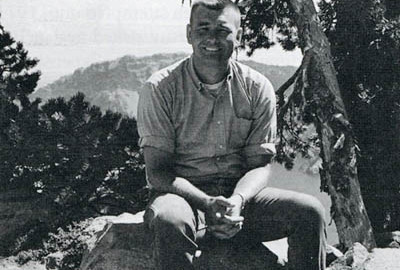I went back to Crater Lake the next three summers and repeated my work. All four summers I obtained the same results as far as Secchi disk readings went. I don’t think I ever had a reading over 35 meters. I never said a word about it to anyone except Rouse, Forbes and perhaps a few other park employees. I’d sit down and talk with him each year before I left the park. Mark Forbes, as far as the management staff up there goes, was really the only one who encouraged my work and expressed interest in what was going on. The other people just seemed indifferent and some people actually felt a little threatened.
I worked at Crater Lake as a volunteer in the park from 1978 through 1981. I continued to document my research findings and each year sent a progress report to the Seattle office pointing out that sewage could be getting into the lake. I never reported this to the news media. I kept it to myself, except that I may have discussed it with Mike Gilmore or John Salinas briefly just as a hypothesis. I’m not sure how this information got into Denny Smith’s hands. He was a congressman from the 4th Congressional District in Oregon. At that time, he was involved with the boundary legislation in Congress. I think that was Public Law 97-250, I believe.
I heard through the grapevine that one of my annual investigator’s reports was passed along by someone in the Park Service to someone in DC, who then gave it to Denny Smith. The next thing I know Denny Smith — this was reported by the Oregonian in December, 1981 — was concerned about the possible pollution of Crater Lake. He wanted to explore any link between sewage disposal up there and the lake’s alleged optical deterioration. Smith proposed to amend the legislation before Congress with an amendment that would direct the Park Service to engage in studies that would determine if the lake was being polluted. I don’t recall the exact wording. The emphasis was placed on finding out if this optical deterioration is real, and secondly, if indeed it is, then determine the source. It called for a long term monitoring program, and was explicit in its direction. It directed the Park Service to find the source of the problem. That was the purpose of this 10-year study. In the few weeks subsequent to this, Jim Larson and a person named Shirley Clark from the regional office called me and asked if I would be interested in working for them on a part time basis to set up a limnological monitoring program for them at Crater Lake (24). I said fine, I’d love to do that. They talked about hiring a fill time lirnnologist there in the long run. They sort of suggested that you’re the man we want. This is what I really wanted. I would like nothing better than to work as the limnologist at Crater Lake. It would have been a wonderful opportunity and was a dream come true. So I said yes, 1’11 do this but stipulated that you’ve got to write a letter to the Corps and request my time.


